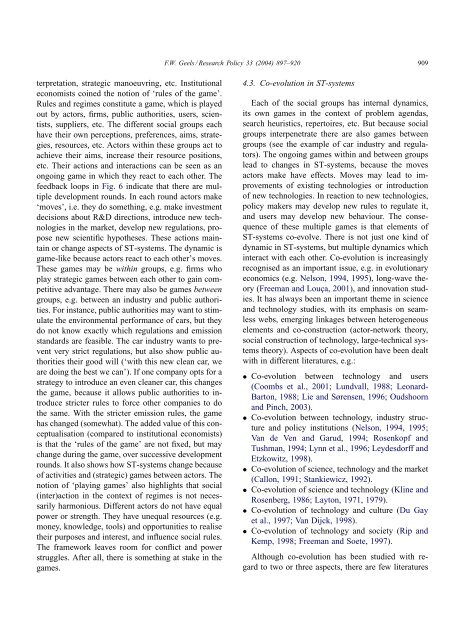From sectoral systems of innovation to socio-technical systems ...
From sectoral systems of innovation to socio-technical systems ...
From sectoral systems of innovation to socio-technical systems ...
You also want an ePaper? Increase the reach of your titles
YUMPU automatically turns print PDFs into web optimized ePapers that Google loves.
F.W. Geels / Research Policy 33 (2004) 897–920 909<br />
terpretation, strategic manoeuvring, etc. Institutional<br />
economists coined the notion <strong>of</strong> ‘rules <strong>of</strong> the game’.<br />
Rules and regimes constitute a game, which is played<br />
out by ac<strong>to</strong>rs, firms, public authorities, users, scientists,<br />
suppliers, etc. The different social groups each<br />
have their own perceptions, preferences, aims, strategies,<br />
resources, etc. Ac<strong>to</strong>rs within these groups act <strong>to</strong><br />
achieve their aims, increase their resource positions,<br />
etc. Their actions and interactions can be seen as an<br />
ongoing game in which they react <strong>to</strong> each other. The<br />
feedback loops in Fig. 6 indicate that there are multiple<br />
development rounds. In each round ac<strong>to</strong>rs make<br />
‘moves’, i.e. they do something, e.g. make investment<br />
decisions about R&D directions, introduce new technologies<br />
in the market, develop new regulations, propose<br />
new scientific hypotheses. These actions maintain<br />
or change aspects <strong>of</strong> ST-<strong>systems</strong>. The dynamic is<br />
game-like because ac<strong>to</strong>rs react <strong>to</strong> each other’s moves.<br />
These games may be within groups, e.g. firms who<br />
play strategic games between each other <strong>to</strong> gain competitive<br />
advantage. There may also be games between<br />
groups, e.g. between an industry and public authorities.<br />
For instance, public authorities may want <strong>to</strong> stimulate<br />
the environmental performance <strong>of</strong> cars, but they<br />
do not know exactly which regulations and emission<br />
standards are feasible. The car industry wants <strong>to</strong> prevent<br />
very strict regulations, but also show public authorities<br />
their good will (‘with this new clean car, we<br />
are doing the best we can’). If one company opts for a<br />
strategy <strong>to</strong> introduce an even cleaner car, this changes<br />
the game, because it allows public authorities <strong>to</strong> introduce<br />
stricter rules <strong>to</strong> force other companies <strong>to</strong> do<br />
the same. With the stricter emission rules, the game<br />
has changed (somewhat). The added value <strong>of</strong> this conceptualisation<br />
(compared <strong>to</strong> institutional economists)<br />
is that the ‘rules <strong>of</strong> the game’ are not fixed, but may<br />
change during the game, over successive development<br />
rounds. It also shows how ST-<strong>systems</strong> change because<br />
<strong>of</strong> activities and (strategic) games between ac<strong>to</strong>rs. The<br />
notion <strong>of</strong> ‘playing games’ also highlights that social<br />
(inter)action in the context <strong>of</strong> regimes is not necessarily<br />
harmonious. Different ac<strong>to</strong>rs do not have equal<br />
power or strength. They have unequal resources (e.g.<br />
money, knowledge, <strong>to</strong>ols) and opportunities <strong>to</strong> realise<br />
their purposes and interest, and influence social rules.<br />
The framework leaves room for conflict and power<br />
struggles. After all, there is something at stake in the<br />
games.<br />
4.3. Co-evolution in ST-<strong>systems</strong><br />
Each <strong>of</strong> the social groups has internal dynamics,<br />
its own games in the context <strong>of</strong> problem agendas,<br />
search heuristics, reper<strong>to</strong>ires, etc. But because social<br />
groups interpenetrate there are also games between<br />
groups (see the example <strong>of</strong> car industry and regula<strong>to</strong>rs).<br />
The ongoing games within and between groups<br />
lead <strong>to</strong> changes in ST-<strong>systems</strong>, because the moves<br />
ac<strong>to</strong>rs make have effects. Moves may lead <strong>to</strong> improvements<br />
<strong>of</strong> existing technologies or introduction<br />
<strong>of</strong> new technologies. In reaction <strong>to</strong> new technologies,<br />
policy makers may develop new rules <strong>to</strong> regulate it,<br />
and users may develop new behaviour. The consequence<br />
<strong>of</strong> these multiple games is that elements <strong>of</strong><br />
ST-<strong>systems</strong> co-evolve. There is not just one kind <strong>of</strong><br />
dynamic in ST-<strong>systems</strong>, but multiple dynamics which<br />
interact with each other. Co-evolution is increasingly<br />
recognised as an important issue, e.g. in evolutionary<br />
economics (e.g. Nelson, 1994, 1995), long-wave theory<br />
(Freeman and Louça, 2001), and <strong>innovation</strong> studies.<br />
It has always been an important theme in science<br />
and technology studies, with its emphasis on seamless<br />
webs, emerging linkages between heterogeneous<br />
elements and co-construction (ac<strong>to</strong>r-network theory,<br />
social construction <strong>of</strong> technology, large-<strong>technical</strong> <strong>systems</strong><br />
theory). Aspects <strong>of</strong> co-evolution have been dealt<br />
with in different literatures, e.g.:<br />
• Co-evolution between technology and users<br />
(Coombs et al., 2001; Lundvall, 1988; Leonard-<br />
Bar<strong>to</strong>n, 1988; Lie and Sørensen, 1996; Oudshoorn<br />
and Pinch, 2003).<br />
• Co-evolution between technology, industry structure<br />
and policy institutions (Nelson, 1994, 1995;<br />
Van de Ven and Garud, 1994; Rosenkopf and<br />
Tushman, 1994; Lynn et al., 1996; Leydesdorff and<br />
Etzkowitz, 1998).<br />
• Co-evolution <strong>of</strong> science, technology and the market<br />
(Callon, 1991; Stankiewicz, 1992).<br />
• Co-evolution <strong>of</strong> science and technology (Kline and<br />
Rosenberg, 1986; Lay<strong>to</strong>n, 1971, 1979).<br />
• Co-evolution <strong>of</strong> technology and culture (Du Gay<br />
et al., 1997; Van Dijck, 1998).<br />
• Co-evolution <strong>of</strong> technology and society (Rip and<br />
Kemp, 1998; Freeman and Soete, 1997).<br />
Although co-evolution has been studied with regard<br />
<strong>to</strong> two or three aspects, there are few literatures



